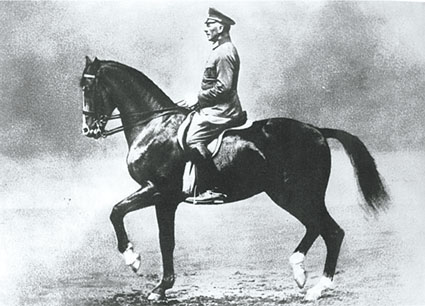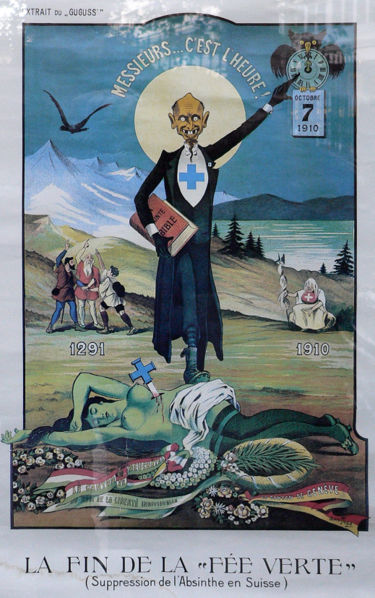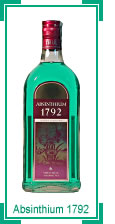
HIDEOUS ABSINTHE by Jad Adams is published in the US by the University of Winsin Press at $24.95.
Respected absinthe writer Jad Adams has a different point of view to absinthe manufacturer T.A Breaux:
JAD ADAMS, AUTHOR, “HIDEOUS ABSINTHE”: Well, the main dangerous from absinthe is it is very highly alcoholic. It‘s up to 75 percent alcohol by volume. So that‘s 150 proof. That‘s the most important danger from it, is that you‘re not likely to drink that much strong alcohol normally with any other kind of drink.
The other thing that it has is a chemical called thujone, which is a mind stimulant. And this was the stimulant that the artists of the 19th century were interested in taking because it gave them new and different ideas and bizarre fantasies. And that‘s the other factor that makes absinthe a different kind of drink from any other kind of thing.
COSBY: Yeah, Jad, you were hearing about these reports of hallucinations. How wide-ranging are they? And how severe could they be?
ADAMS: Well, that depends on the strength of the thujone. Now, you can buy absinthe in a lot of countries in Europe, but the European Union restricts the amount of thujone, the active ingredient, to 10 parts per million. So that‘s not very much. However, there is available a lot of black-market absinthe with people make in their own private stills, producing this stuff for sale on the black market, and that can be five or 10 times stronger. So you can actually get a much more strongly hallucinogenic product.
COSBY: Well, you know, Jad, I want to—this is from a passenger who was on the ship with George Smith. He claims that a bottle of absinthe was purchased in Italy. Remember, the cruise ship went all over in Europe. You can buy it in Europe. It‘s illegal in the states. In fact, this is how the passenger described how the group, including George Smith, was drinking this: “They drank the whole bottle. When I got there, the bottle was empty.”
Is there any way to tell how potent that would be and how much affect that could have on maybe someone who hasn‘t had this kind of drink before?
ADAMS: Well, unless you actually have the bottle or some of the substance to test, not really, I‘m afraid, though certainly someone who‘s not used to this substance, drinking a lot of it, will find it rather surprising and unusual. They‘re going to have different kinds of ideas.
What absinthe really does, what its active ingredient does, is to take the brakes off the mind, and so the mind is over-stimulated, it‘s having lots of fresh and unusual, strange, bizarre ideas. So that‘s the sort of thing it does.
COSBY: Jad, thank you very much. We appreciate it. Interesting, because a liquor I‘d never heard about this until a few weeks ago.
Well, with more on the potential dangers of this very strong liquor, we are joined tonight by the coauthor of the book “Absinthe: Sip of Seduction,” absinthe historian and also chemist, Theodore Breaux.
Mr. Breaux, you say that it‘s not as dangerous. You have a bit of a different take. Why is that?
THEODORE BREAUX, ABSINTHE HISTORIAN AND CHEMIST: Well, first of all, I appreciate what Mr. Adams says, but his science is about 30 years behind. You see, the thing is, is that was a longstanding belief about absinthe containing lots of thujone and that caused hallucinations. But nowadays, we know that that‘s not true.
Personally, I‘ve studied absinthe for about 13 years. And when I say studied absinthe, I‘ve studied absinthe from 100 years old, such as this bottle that I‘m holding up, which has been unopened, except for the removal of samples for scientific analysis, as well as new absinthes, which are made—some of them which are made exactly like the old ones were.
And the one thing we know is that absinthe, old and new, does not contain a lot of thujone. And what we know, from certain scientific studies, which have been published in the past year or so, is that, first of all, thujone is not present in any absinthe in sufficient concentration to cause any type of deleterious effects in humans. For me…
(CROSSTALK)
COSBY: You‘re talking about hallucinations, right, in layman‘s terms?
BREAUX: Oh, there are no hallucinations, so the only hallucinations that one will find is in reading 19th century romantic literature. In reality, it doesn‘t exist.
COSBY: But, Mr. Breaux, let me read you also—this is interesting.
We‘re looking at the alcohol content, at least of absinthe, versus beer. Absinthe has an alcohol content of about 68 percent, while beer is a little closer to 4 percent or 5 percent. When you look at that, that‘s a pretty big difference!
BREAUX: That‘s correct. And that‘s the thing. You take any high-proof alcohol, whether it be a high-proof rum, absinthe or anything else, and you just imbibe it with, you know, without reservation, well, something‘s going to happen. I mean, you take two people and sit down to a bottle of 80-proof tequila, I guarantee before you get to the bottom of that bottle someone‘s going to be dancing on the tables. You know, I mean, there‘s nothing…
COSBY: You know, we hear now that the bottle was empty. Do you think it could have played a role in this case somehow?
BREAUX: Absolutely not. Absolutely not.
COSBY: No?
BREAUX: And any absinthe that is sold in Europe does not contain enough thujone to cause any hallucinations. I would have to consume about three liters of absinthe at the European limit to have any clinically discernable effects from thujone, and I‘d be long dead from the alcohol by that point.
Rita Cosby: Live and Direct January 24th 2006























